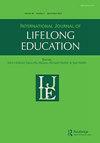Adult numeracy skill practice by STEM and non-STEM workers in the USA: an exploration of data using latent class analysis
IF 1.9
Q2 EDUCATION & EDUCATIONAL RESEARCH
引用次数: 1
Abstract
ABSTRACT Adult numeracy is one of the essential skill sets to navigate through numeric information-rich labour markets in general, and STEM industries in particular. Yet, relatively little is known about how numeracy skills are used in different settings in the USA. This study examined numeracy skill use patterns of STEM and non-STEM workers at work and home. Data were obtained from the 2012/2014/2017 Program for International Assessment of Adult Competencies, USA restricted-use file. Adults who were employed and aged between 25 and 65 years old (n = 5,220) were included in this study. Latent class analysis revealed four numeracy skill use patterns: non-users, non-occupational (i.e. at home) simple numeracy users, ubiquitous numeracy users, and occupational numeracy users. Additional multinomial logistic regression analysis showed that the STEM occupation was associated with a greater likelihood of being ubiquitous users than being non-occupational simple users. Results also showed that numeracy proficiency, socioeconomic statuses (i.e. educational attainment and income), as well as demographic characteristics (i.e. gender and race/ethnicity), were predictive of the numeracy skill use patterns in terms of the level of engagement and settings. Findings from this study inform policies and interventions which promote skill engagement and improvement among workers in the USA.美国STEM和非STEM工作者的成人算术技能实践:使用潜在类别分析的数据探索
摘要:成年人的算术能力是驾驭数字信息丰富的劳动力市场,尤其是STEM行业的基本技能之一。然而,人们对算术技能在美国不同环境中的使用方式知之甚少。这项研究调查了STEM和非STEM工作者在工作和家庭中的算术技能使用模式。数据来自美国2012/2014/2017年国际成人能力评估计划的限制使用文件。本研究包括年龄在25岁至65岁之间的在职成年人(n=5220)。潜在类别分析揭示了四种算术技能使用模式:非使用者、非职业(即在家)简单算术使用者、普遍算术使用者和职业算术使用者。其他多项逻辑回归分析表明,STEM职业比非职业简单用户更容易成为普遍用户。结果还表明,算术能力、社会经济地位(即教育程度和收入)以及人口统计学特征(即性别和种族/民族)可以预测参与程度和环境方面的算术技能使用模式。这项研究的结果为促进美国工人技能参与和提高的政策和干预措施提供了信息。
本文章由计算机程序翻译,如有差异,请以英文原文为准。
求助全文
约1分钟内获得全文
求助全文
来源期刊

International Journal of Lifelong Education
EDUCATION & EDUCATIONAL RESEARCH-
CiteScore
3.10
自引率
27.80%
发文量
40
期刊介绍:
The International Journal of Lifelong Education provides a forum for debate on the principles and practice of lifelong, adult, continuing, recurrent and initial education and learning, whether in formal, institutional or informal settings. Common themes include social purpose in lifelong education, and sociological, policy and political studies of lifelong education. The journal recognises that research into lifelong learning needs to focus on the relationships between schooling, later learning, active citizenship and personal fulfilment, as well as the relationship between schooling, employability and economic development.
 求助内容:
求助内容: 应助结果提醒方式:
应助结果提醒方式:


